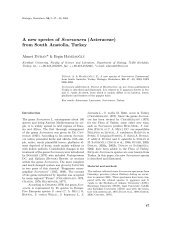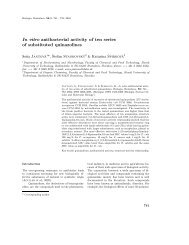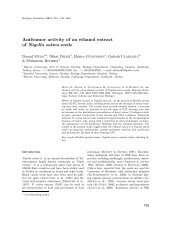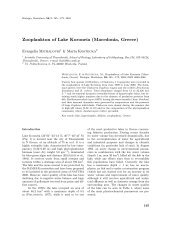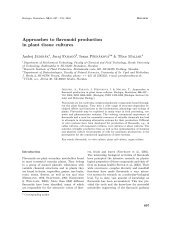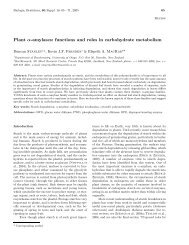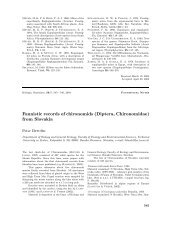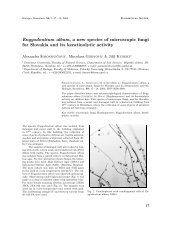Detection of Salmonella by polymerase chain reaction - Biologia ...
Detection of Salmonella by polymerase chain reaction - Biologia ...
Detection of Salmonella by polymerase chain reaction - Biologia ...
You also want an ePaper? Increase the reach of your titles
YUMPU automatically turns print PDFs into web optimized ePapers that Google loves.
in the presence <strong>of</strong> 10 6 CFU <strong>of</strong> E. coli (data not<br />
shown).<br />
<strong>Detection</strong> <strong>of</strong> <strong>Salmonella</strong> in foods<br />
The performance <strong>of</strong> the developed detection system<br />
was evaluated <strong>by</strong> the analysis <strong>of</strong> naturally<br />
contaminated food samples. Two enrichment<br />
protocols were used prior to PCR: a one-step<br />
overnight non-selective enrichment in BPW, and a<br />
three-step selective enrichment comprising a preenrichment<br />
in BPW, two parallel selective enrichments<br />
in Rappaport-Vassiliadis and selenitecystine<br />
media, respectively, and post-enrichment<br />
in LB broth. Of the 18 food samples tested, 9 were<br />
found positive <strong>by</strong> the ISO method. Identical results<br />
were obtained <strong>by</strong> the PCR detection coupled<br />
to an overnight enrichment in BPW, but one sample<br />
<strong>of</strong> chicken meat was found false negative and<br />
two samples <strong>of</strong> minced meat were found slightly<br />
false positive. PCR after a three-step enrichment<br />
produced identical results as the reference method<br />
(Tab. 4).<br />
Table 4. <strong>Detection</strong> <strong>of</strong> <strong>Salmonella</strong> in foods. Value in<br />
brackets means a slightly positive result (faint band in<br />
the electrophoresis).<br />
No. <strong>of</strong><br />
Sample type tested Positive <strong>by</strong><br />
samples<br />
PCR-BPW PCR-LB ISO 6579<br />
egg melange 5 2 2 2<br />
minced meat 8 (2) 0 0<br />
chicken meat 2 1 2 2<br />
chicken liver 1 1 1 1<br />
turkey meat 2 2 2 2<br />
Discussion<br />
The aim <strong>of</strong> the present study was to develop<br />
a rapid PCR-based system for the detection <strong>of</strong><br />
<strong>Salmonella</strong> in foods. We designed original primers<br />
S212/S500 targeted to the fimC gene, which<br />
proved to be <strong>Salmonella</strong>-specific with no crossreactivity<br />
to the other bacterial species tested.<br />
These primers were also successful in amplifying<br />
a specific DNA product from S. gallinariumpullorum<br />
although type1 fimbriae are not expressed<br />
in this serotype; this result is in agreement<br />
with the observation <strong>by</strong> Cohen et al.<br />
(1996).<br />
Sensitivity <strong>of</strong> the developed PCR, 100 CFU<br />
per <strong>reaction</strong> using a template obtained <strong>by</strong> a simple<br />
bacterial lysis was similar to that <strong>of</strong> other comparable<br />
PCR methods recommended for routine<br />
laboratories (Rijpens et al., 1999; Trkov et al.,<br />
1999). Although this might be improved <strong>by</strong> increasing<br />
the number <strong>of</strong> amplification cycles, because<br />
<strong>of</strong> the accompanying danger <strong>of</strong> false positive<br />
results caused <strong>by</strong> contamination, a combination <strong>of</strong><br />
less amplification cycles with an appropriate enrichment<br />
prior to PCR is preferred.<br />
With PCR-based detection methods, a problem<br />
<strong>of</strong> false negative results caused <strong>by</strong> inhibition<br />
may occur. Various components <strong>of</strong> food, enrichment<br />
media or DNA extraction solutions have<br />
been shown to inhibit PCR (Rossen et al., 1992).<br />
False negative results are more dangerous than the<br />
false positive ones because they may lead to contaminated<br />
samples being judged as safe. To avoid<br />
false negative results, we have prepared an internal<br />
standard, which facilitates monitoring the amplification.<br />
The application <strong>of</strong> this internal standard<br />
proved to be useful since, with the analysis <strong>of</strong> some<br />
food samples, inhibition did take place. By repeating<br />
PCR for these samples, eventual false negative<br />
results were avoided.<br />
When testing the complete detection system<br />
with naturally contaminated foods, a good agreement<br />
with the results <strong>of</strong> the standard method was<br />
observed. However, some discrepancies appeared<br />
at a one-step enrichment used prior to PCR. The<br />
two false positive samples <strong>of</strong> minced meat, which<br />
produced faint bands in PCR coupled to a one-step<br />
enrichment, but not in the standard method or<br />
when a three-step enrichment was used, were probably<br />
caused <strong>by</strong> the presence <strong>of</strong> dead <strong>Salmonella</strong><br />
cells in the food. The false negative sample <strong>of</strong><br />
chicken meat, which was negative at PCR coupled<br />
to a one-step enrichment, but positive in the standard<br />
method or when a three-step enrichment was<br />
used, was probably contaminated at a low level or<br />
<strong>by</strong> stressed <strong>Salmonella</strong> cells. When summarized,<br />
the use <strong>of</strong> a three-step enrichment prior to PCR<br />
lead to a higher agreement <strong>of</strong> the results with the<br />
standard method, but required considerably more<br />
time. For screening purposes, a one-step enrichment<br />
may be used but the problem <strong>of</strong> possible<br />
false positive an false negative results has to be<br />
kept in mind.<br />
Acknowledgements<br />
This study was supported <strong>by</strong> the Inco-Copernicus<br />
grant (No. PL979044) from EU.<br />
615



